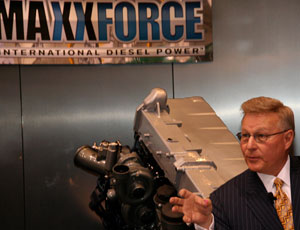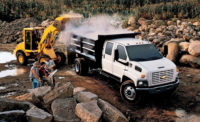Navistar International Corp. will be rolling into 2011 offering heavy trucks equipped only with Navistar power—a move that dealers, truckers and investors will be watching closely in a market that is expected to see 50% to 60% gains in sales next year.

The Warrenville, Ill.-based manufacturer will also be the only truck maker not using selective-catalytic reduction (SCR), a clean-air technology that requires drivers to fill up a tank of urea periodically to neutralize nitrogen-oxides (NOx) in the engine’s exhaust.
Navistar executives dub SCR a hassle and allege that other truck brands using it allow drivers to run unchecked, with the urea tank empty or full of water. “Our engine strategy is working very well,” says Roy Wiley, Navistar spokesman. “Orders are up; customers are pleased.”
Previously, Navistar had stockpiled rival Cummins engines in preparation for its big clean-diesel launch earlier this year. But no longer will it offer a red Cummins in its trucks. Due to the vertical integration and its lone-wolf emissions strategy, Navistar lately has attracted its share of skeptics. One Midwest Navistar dealer told ENR on the condition on anonymity that the “jury’s still out” on the company’s strategy. The dealer added, though, that it thought Navistar's engine technology was “solid.”
One Wall Street analyst has been warning investors that Navistar�s path is too risky. “SCR is being rapidly accepted,” says Charles Rentschler of Philadelphia-based Boenning and Scattergood, and former Cummins employee. “You have the additional nuisance, but that supply line is in place, and it’s not a big deal.”
Prior to 2008, Cummins, too, was on track to supply engines without SCR. But it made a technical U-turn and decided to use SCR to get its emissions levels down in January 2010—when the U.S. Environmental Protection Agency began enforcing the latest standard. Fuel economy gains of up to 5% are one reason why Cummins and other manufacturers have supported SCR.
That leaves Navistar with a unique path, and it is costing the company money. Its net income fell 55% in the fourth quarter and 30% for its full fiscal year ending Oct. 31. The engine business booked a $17-million loss in the fourth quarter due to the loss of business with Ford and the added research-and-development costs of the new engine.
Adding fuel to the fire, Navistar has been openly sparring with other manufacturers over the merits of SCR.
“I would call it a jihad, myself,” says David McKenna, director of powertrain sales and marketing for Mack Trucks Inc., Allentown, Pa. “I’ve been in the business for 37 years, and I have never seen the acrimony.”
Navistar says it will gain market share next year with a clean-diesel engine that requires just a fuel-fill. In January, Navistar will begin shipping a new 15-liter engine targeted mainly at severe-duty vehicles, such as construction trucks, after introducing a new 13-liter this year.
“This is a free country,” says Wiley. “If they want to go SCR, they can go SCR. We’re not like the other guys.”
Credit Where Credit Is Due
Navistar also has plenty of supporters on it side. “You know how I really know you can buy Navistar? Because it is part of a major bull market,” said Mad Money’s Jim Cramer on Dec. 22, when Navistar reported its year-end results.
But there is a long-term rub. Navistar’s new engine, called MaxxForce and incorporating “advanced” exhaust-gas recirculation (EGR) technology, doesn’t strictly meet U.S. Environmental Protection Agency tailpipe limits. Navistar’s MaxxForce engines currently release 0.4 to 0.5 grams per brake-horsepower-hour of NOx, at least double what EPA started requiring this past January.
Navistar gets to skirt the EPA limit by spending NOx credits that it earned with previous engines that exceeded standards. According to Navistar, it has two-to-three years’ worth of federal credits left until it must produce engines that meet 0.2 g/bhp of NOx.
The advanced EGR strategy is an inside-out approach. It aims to clean the air within the confines of the combustion cylinder by pushing in large volumes of air to reduce the heat of combustion, which lowers NOx. In contrast, SCR allows the engine to run hotter, which increases NOx, then cleans the tailpipe by dosing urea into the exhaust.
Construction fleet managers have told ENR that they actually prefer the Navistar method as more off-road engines adopt the on-road EPA standards. For them, a large concern is the distribution of the urea outside of the truck stop, where it is readily available today, and out on the jobsite, where refueling logistics are trickier.
“We are going to face a supply-chain issue with this stuff, just because of the variety of conditions we work in,” says Arne Ruud, corporate equipment manager for Atkinson Construction, Broomfield, Colo. “It’s just going to be tough for us.”
One answer to Navistar's problem may be found in what some call "dry SCR.” Last year, Navistar announced that it was teaming up with a Danish supplier called Amminex to add a solid catalyst to its engines to neutralize NOx and eliminate “the need for customers and third parties to invest in a new infrastructure for liquid urea,” said Jack Allen, president of Navistar’s North American Truck Group.
In any event, SCR supporters argue that Navistar's unique method will increase particulate emissions, requiring a truck's diesel-particulate filter to burn off soot more often, a process that requires more heat and reduces fuel economy.
“There’s certain immutable laws of physics,” says McKenna. “A massive EGR engine simply cannot get better fuel economy.”
However, Daniel C. Ustian, Navistar’s CEO, promised investors on Dec. 22 that fuel economy will be up on its Advanced EGR engines that meet the 0.2 standard.
“The fuel economy of the point-two will be better,” he said.



Post a comment to this article
Report Abusive Comment